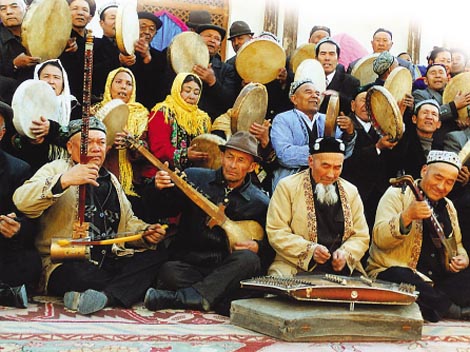The most celebrated music in Xinjiang today is Uygur folk music, which has inherited the fine traditions of the ancient music of Qiuci, Gaochang (Karahoja),Yizhou, Shule and Yutian.



Due to the particular geography of Xinjiang and the constant influence of one culture on another, musical styles have developed along different paths over the years, and each tradition is typical of its locality. There are three distinct styles of Xinjiang music: Southern Xinjiang, Eastern Xinjiang and the Daolang area.
Southern Xinjiang is vast, and the content and form of its music varies from place to place. For example, Hotan folk songs are simple, short and primitive, reflecting the flavor of the land. Kashgar folk songs, however, have a sophisticated rhythm, while Kuqa folk songs are lively, boisterous and perfect for dancing.
In Eastern Xinjiang, folk songs have the same structure as those of Han's and Mongolian folk songs.

Daolang area folk songs, from the western edge of the Tarim Basin, have an unrestrained style, retaining the mood of its ancient herdsmen.
In the Yili area, a large number of Uygur immigrants have helped to develop yet another style of Uygur music represented by drawn-out soulful tunes. A number of their songs are narrated and chantable.
There are several kinds of traditional Uygur music, the most famous of which is the classic Uygur musical composition the "Twelve Muqam", a major force in the development of Uygur folk music. This artistic gem combines folk music and dancing, and includes more than 340 classical songs, folk songs and pieces of dance and instrumental music. It has enticed people in both Northern and Southern Xinjiang for generations. Changing from overtures to allegrettos, followed by allegros, "The Twelve Muqam" lasts more than 20 hours. The piece was systematically recorded and published a few years ago.
Another kind of Uygur music is called "Sanam," or "beauty," which involves singing and dancing to a group consisting of between seven to a dozen pieces of song-and-dance music. The music begins slowly and steadily, then picks up speed, and finally culminates in a climax of merry music and exuberant dances.

"Kuxak," "Eytixish," and "Maida" are spoken songs, which are common among the Uygur people. Accompanied by simple tunes, the speaker will talk his way through a song, usually about the love between a man and a woman. These songs can also be performed by two people.
Uygur music is accompanied by a variety of instruments. Back in the Sui (581-618) and Tang (618-907) dynasties, the five-stringed pipa (a plucked string instrument with a fretted fingerboard) and konghou (harp, an ancient plucked stringed instrument) were popular in Qiuci and other areas. They arrived in the Central Plains along with music from the Western Region. The present Uygur music developed from ancient musical instruments from the Western Region as well as modern Chinese and foreign instruments; it includes dozens of stringed, wind and percussion instruments.





